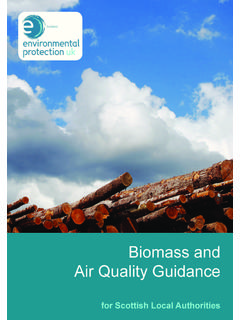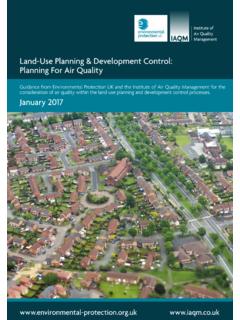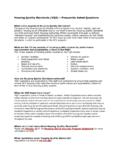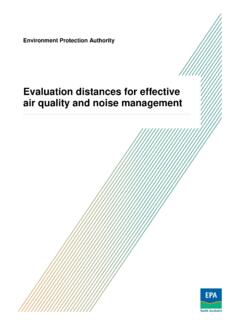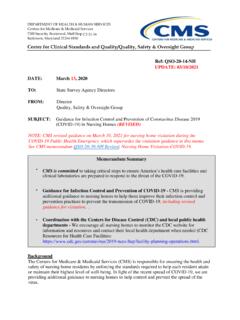Transcription of Clean Air Fund - GOV.UK
1 Clean Air Fund Published as part of the government response to the consultation on additional measures to support individuals and businesses affected by local nitrogen dioxide plans March 2018 Crown copyright 2018 You may re-use this information (excluding logos) free of charge in any format or medium, under the terms of the Open Government Licence To view this licence visit or email This publication is available at Any enquiries regarding this publication should be sent to us at Joint air quality Unit Area 2C Nobel House 17 Smith Square London SW1P 3JR Email: Contents Objective of the Clean Air Fund .. 1 Funding available .. 2 Scope of the Fund .. 3 Buses/Coach companies and bus passengers .. 4 HGVs/Freight drivers and 6 Van drivers which could include small businesses.
2 7 Individuals who currently use a non-compliant car, which could include low income households, residents in a Clean Air Zone or commuters .. 7 Taxi and private hire vehicle drivers .. 10 1 We ve published Section 2 of the summary of responses in this document for ease of reference. Objective of the Clean Air Fund 1. The Clean Air Fund s objective is to support individuals and businesses affected by local nitrogen dioxide plans. Government has encouraged local authorities to prioritise approaches that achieve compliance with legal limits in the shortest possible time whilst minimising the impact on those living and working in and around the area. However, it is likely that in some cases local authorities will identify measures that could impact individuals and businesses such as charging Clean air zones as the fastest means of achieving compliance.
3 Depending on the scope of vehicles covered by such a zone this could particularly impact on low income families, small businesses and people living or working in a particular area. The objective of the Clean Air Fund is to help local authorities to support those impacted by their specific local plan. The objective can be delivered in three main ways: a) By introducing measures that will make it easier, more attractive or more affordable for individuals and businesses to change to cleaner modes of transport that will not face any restrictions under local plans. For instance, if a local authority has concluded that reaching compliance will require it to restrict vehicle access to the city centre for three days each week, the Clean Air Fund could support measures that would make it easier to change to alternative modes of transport such as improving the cycling and walking infrastructure, boosting local bus services or supporting park and ride facilities.
4 This would give individuals better options on days their cars are not a viable transport mode. b) By enabling the local authority to implement local plans that collectively impact on fewer people. For example if a local authority identified the following two approaches that achieve compliance equally as quickly: a) implementing a class C1 charging Clean Air Zone; or b) implementing a class B2 charging Clean Air Zone3 and additional measures (for instance a freight consolidation centre). Option b) would impact less people as vans would no longer be in scope for charging but has an additional cost to fund the additional measures - the Clean Air Fund could potentially support these additional measures. 1 Class C charging CAZ includes buses, coaches, taxis, private hire vehicles (PHVs), heavy goods vehicles (HGVs) and light goods vehicles (LGVs) 2 Class B charging CAZ includes uses, coaches, taxis, PHVs and HGVs 3 Further information on charging zone classes is available in section of the NO2 Plan: 2 c) By reducing transport costs for people.
5 For instance if a local authority identified that the measure that would bring forward compliance in the shortest time was a class D charging Clean Air Zone (which applies to all vehicle types), the Clean Air Fund could support local travel discounts for low income households in the area to help provide them with alternative transport options in the zone. 2. Evidencing the need for Clean Air Fund intervention will be part of local authorities developing their local plans, which will include an assessment of the distributional impacts how the proposed measures to reduce nitrogen dioxide pollution will impact different groups of individuals and businesses. A strong application from a local authority for the Clean Air Fund will both robustly evidence the need for funding by clearly setting out the impacts of the local plan on individuals and businesses, and establish how the proposals for the Clean Air Fund minimise these impacts.
6 Funding available 3. There is 220 million of funding available through the Clean Air Fund over the period of 2018/19 to 2020/21. It is our intention that successful local authorities will receive the funding award from the Clean Air Fund at the same time as they are awarded funding from the Implementation Fund. The funding may be paid out in tranches over several financial years. 4. Successful applicants to the Clean Air Fund will be expected to deliver measures supported through the fund in parallel to their local plan. Funding from the Clean Air Fund will be allocated on a rolling basis to support local authorities in delivering their plans in the shortest possible time. 5. Funding is allocated according to the quality of proposals, with particular importance being placed on the extent to which the Clean Air Fund bid addresses a real need (as evidenced by a distributional analysis).
7 There is no upper limit for awards that can be made to any single authority and there is no guarantee of a minimum award. Clean Air Fund proposals will need to set out that the intervention has no negative impact on air quality , that there is a clear rationale for intervention, that it addresses the spending objective, has a credible delivery plan and can demonstrate value for money. 6. English local authorities that are named in the UK Plan for Tackling Roadside Nitrogen Dioxide Concentrations as having to undertake feasibility studies are eligible to apply for support from the Clean Air Fund. The Greater London Authority has separate funding arrangements in place with HMG. London received a billion settlement from the government for the period between 2016 and 2021 and has received a further 92 million for other measures to address air pollution, including low emission buses.
8 Reflecting that previous funding to London, this new targeted fund is for local authorities outside London. air quality is a devolved matter 3 and local authorities in the devolved administrations are therefore not eligible to apply for the Clean Air Fund. 7. The Clean Air Fund was launched alongside publication of this response. The development, submission and assessment of proposals for the Clean Air Fund will happen as part of the development of the local plan feasibility studies. The five local authorities included in the 2015 plan for tackling nitrogen dioxide (Birmingham, Derby, Leeds, Nottingham and Southampton) will follow an accelerated version of this process as their business cases are already in progress. Scope of the Fund 8.
9 As set out in the consultation responses, there is broad support for a wide range of measures that could be funded through the Clean Air Fund. The most appropriate measures will depend on the local situation and the results of the local authority s analysis of the distributional impacts in their plans. We have concluded that the Clean Air Fund should be intervention-neutral and outcome-focussed to enable local authorities to put forward proposals that best fit their local situation. Therefore, the Clean Air Fund could support a wide range of measures including, but not limited to: community-wide measures such as road layout changes, changes to cycling or walking infrastructure, improved public transport, park and ride schemes, promoting car clubs, vehicle retrofit; or better travel planning services; or measures aimed directly at supporting individuals or businesses such as local travel discounts (which could be linked to smart ticketing), cycle to work schemes, local scrappage schemes or support for upgrading to a new vehicle (including ultra low emission vehicles).
10 9. We will work closely with local authorities as they develop their proposals and will continue to facilitate the exchange of best practice between local authorities . Clean Air Fund proposals will need to set out: Rationale for intervention: Clearly set out the need for mitigation by providing a robust distributional analysis of the impact of local plans on individuals and businesses, following the options appraisal guidance . Addressing the spending objective: Clearly set out the way in which the projects proposed for Clean Air Fund address these impacts and reduce them. Value for money: Demonstrate strong value for money by setting out how the investment made will deliver benefits that meet the Fund s objectives. Proposals will also have to demonstrate additionality; that is funding will not be allocated to existing projects that have received financial support from 4 central government.











